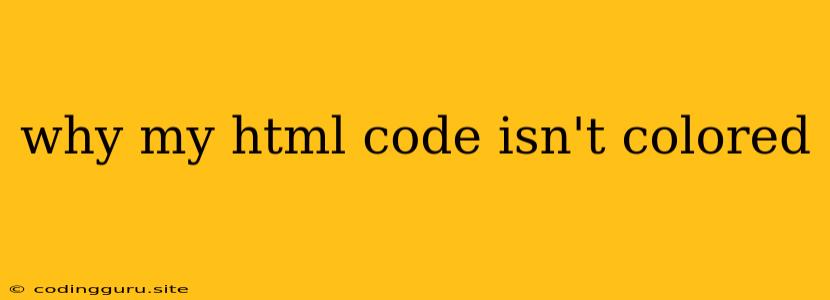Why Isn't My HTML Code Colored?
Have you ever stared at a plain, black-and-white HTML code editor and wondered why your code isn't highlighting different elements with vibrant colors? It's a common frustration for beginners, but don't worry, there's a simple explanation and a few easy fixes.
Understanding Code Syntax Highlighting
Code syntax highlighting is a feature in text editors and IDEs that makes your code more readable and easier to debug. It automatically colors different parts of your code based on their function, like keywords, tags, attributes, and values. This visual cue helps you quickly identify errors, understand the structure of your code, and navigate it more efficiently.
Why Your HTML Code Might Not Be Colored
Here are the most likely reasons your HTML code isn't getting its colorful makeover:
- You're Not Using a Syntax-Highlighting Editor: The most common reason is that you're using a basic text editor like Notepad or TextEdit, which don't have built-in syntax highlighting capabilities.
- The Editor is in Plain Text Mode: Some editors have a "plain text" or "raw text" mode that disables syntax highlighting to ensure you see the code exactly as it is.
- The File Extension is Incorrect: If your HTML file doesn't have the
.htmlextension, the editor might not recognize it as HTML code and won't apply syntax highlighting. - The Syntax Highlighting Feature is Disabled: Your editor might have a setting to enable or disable syntax highlighting. Check the preferences or settings.
- The Editor Doesn't Support HTML Syntax Highlighting: In rare cases, your editor might not have support for HTML syntax highlighting. You might need to try a different editor.
How to Get Your HTML Code Colored
Here are some solutions to bring those colors back to your HTML code:
-
Switch to a Syntax-Highlighting Editor: There are many excellent free and paid code editors with built-in syntax highlighting for HTML and other languages. Some popular choices include:
- VS Code (Visual Studio Code): A popular and powerful open-source editor.
- Sublime Text: A fast and lightweight editor known for its customization options.
- Atom: Another open-source editor with a large community and many extensions.
- Notepad++: A popular Windows-specific editor with excellent syntax highlighting support.
- Brackets: A lightweight editor specifically designed for web development.
-
Enable Syntax Highlighting in Your Current Editor: If you're already using a syntax-highlighting editor, check if the feature is enabled. This usually involves a setting or preference in the editor.
- VS Code: Go to File > Preferences > Settings and search for "syntax highlighting".
- Sublime Text: Go to Preferences > Settings - User and add the following line:
"highlight_line": true - Atom: Go to File > Settings and search for "syntax highlighting".
- Notepad++: Go to Settings > Style Configurator and select a theme with syntax highlighting.
-
Fix the File Extension: Make sure your HTML file has the
.htmlextension. If it doesn't, rename it to include the extension. -
Try a Different Editor: If you've exhausted all other options, consider trying a different editor that is known to support HTML syntax highlighting.
Debugging Tips:
- Check the Editor's Documentation: Refer to the documentation of your editor for information about syntax highlighting and how to configure it.
- Use a Debugger: Some editors have built-in debuggers that can help you identify issues with your code.
- Ask for Help: If you're still having trouble, don't hesitate to seek help from online forums or communities for developers.
Conclusion
Getting syntax highlighting to work in your HTML editor is a simple matter of choosing the right editor, ensuring the correct settings are enabled, and making sure the file has the correct extension. With a little troubleshooting, you can enjoy the benefits of syntax highlighting and write more efficient, error-free HTML code.
